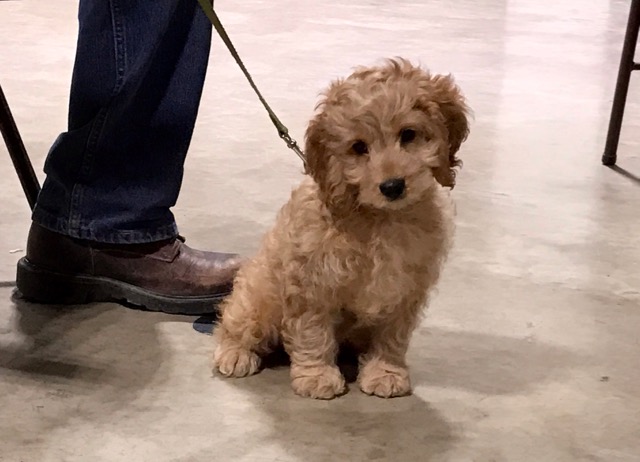Training a puppy into a great dog

Training a puppy into a great companion isn’t difficult. However, it does require investing time each day teaching the new family member the rules of your household. It is important to start teaching the rules early, ideally from the time you bring the furry, little bundle home. Your puppy is learning all the time, so you might as well teach valuable skills that are going to pay off for long term good behavior.
Here are a few of the key puppy training ideas I share in our Preschool program.
- Teach the pup to tolerate being in a crate. The crate will be of great assistance in establishing a housebreaking routine. Plus, it will fend off problems, like nuisance chewing, if you use it as a playpen when you can’t adequately supervise. Helping the puppy learn to be calm and content in the crate, both when you are home in the house and when you are not, is a primary goal. Being calm when crated is valuable if your dog ever needs to stay overnight at a kennel or medical facility. Learning acceptance of confinement early in life pays off in less stress later. Storing favorite toys, feeding occasional meals or hiding a special treat to be “discovered” inside the crate will all help to make a positive association with the space. And make sure to vary the length of time you have the pup remain confined. Sometimes the confinement should only be a few minutes, other times it may be a few hours but don’t limit it to only overnight sleeping arrangements or long hours when you are away at work.
- Spend time each day teaching your puppy to allow handling and restraint. This will help prepare for many necessary lifetime routines. Things like nail trimming, taking a bath, visiting the vet or being brushed and combed can be stressful to a dog who has not learned how to tolerate restraint and handling. If you feed a small treat or allow the pup to chew on a toy while you spend a few minutes each day doing these activities, they will grow up accepting these things as a normal part of life. It is also important to not give in to the puppy squirming or biting at you as you restrain them. Puppies have a 2-3 second association period when they are learning new things. They develop habits based on their behavior and the resulting consequences that happen. If you release a puppy as soon as the young charge wiggles to be free because you rationalize “they don’t like it” the pup quickly learns that mouthing and nipping = you will let them go. This results in more wiggling and nipping when you attempt to restrain the pup the next time! Certainly, the pup is a bit stressed by restraint, but only because it is a new experience for them. As you learn to calmly work through these displays of resistance, your dog will learn to calmly accept this type of handling. You, plus your dog’s groomer, Veterinarian and other care takers will all appreciate Fido having learned these valuable life skills.
- Give your puppy an outlet for their energy. One of the easiest ways to have a well- mannered dog is to make sure he gets enough exercise each day. A tired dog is an easy dog to live with! Fatigue can be achieved in many ways and it does not always have to be through physical exercise. Mental exercise can be energy draining as well. It is great to play games and take short walks, but you might find that spending 5-10 minutes teaching the pup to walk nicely on a leash or teaching them to sit, lay down or come when called is as exhausting as 40 minutes of rousing play. And it certainly will teach your dog beneficial life skills!

- Use your leash. Keeping a 5 or 6 foot standard leash attached to your puppy during the first weeks together can set things on the right course in many ways. It will be easier to monitor your puppy’s activity if you teether him to you when you are distracted watching television or checking social media. A pup that is attached to you can’t slip away unnoticed to have a potty accident in the next room. The leash also makes it easy to interrupt jumping. Placing your foot down on the leash, within a few inches of the buckle, has the effect of anchoring your pup on the floor. With your foot standing on the leash in this way, the jumping attempts quickly become unproductive and unrewarding. Spending 5 – 20 minutes in this anchored position can also be very valuable in teaching Fido to just relax as you carry on a conversation with someone else or spend a few moments having your coffee and checking the news. A pup that is gently forced to relax in this way grows into a dog that does not always demand being the center of attention.
- Finally, remember to reward your puppy for the things he does right. If your dog runs up to you when you call him, reward him. If he sits or stands rather than jumping on you, reward that too. A reward is anything the dog likes; treats, toys or affection. Rewarding your dog for good behavior means you will get more good behavior and it builds a great relationship!
Raising a puppy takes time and consistency, but if you put in the work during the first year, you can be rewarded with sharing a lifetime of wonderful adventures together.

